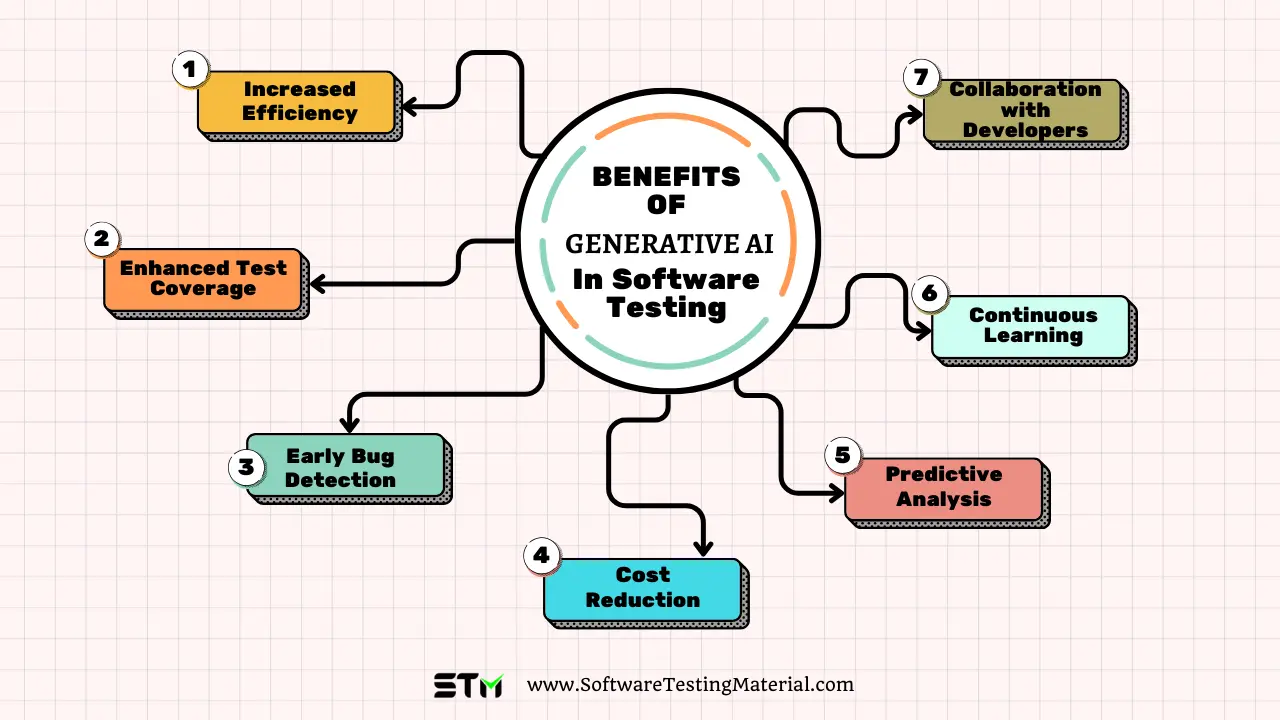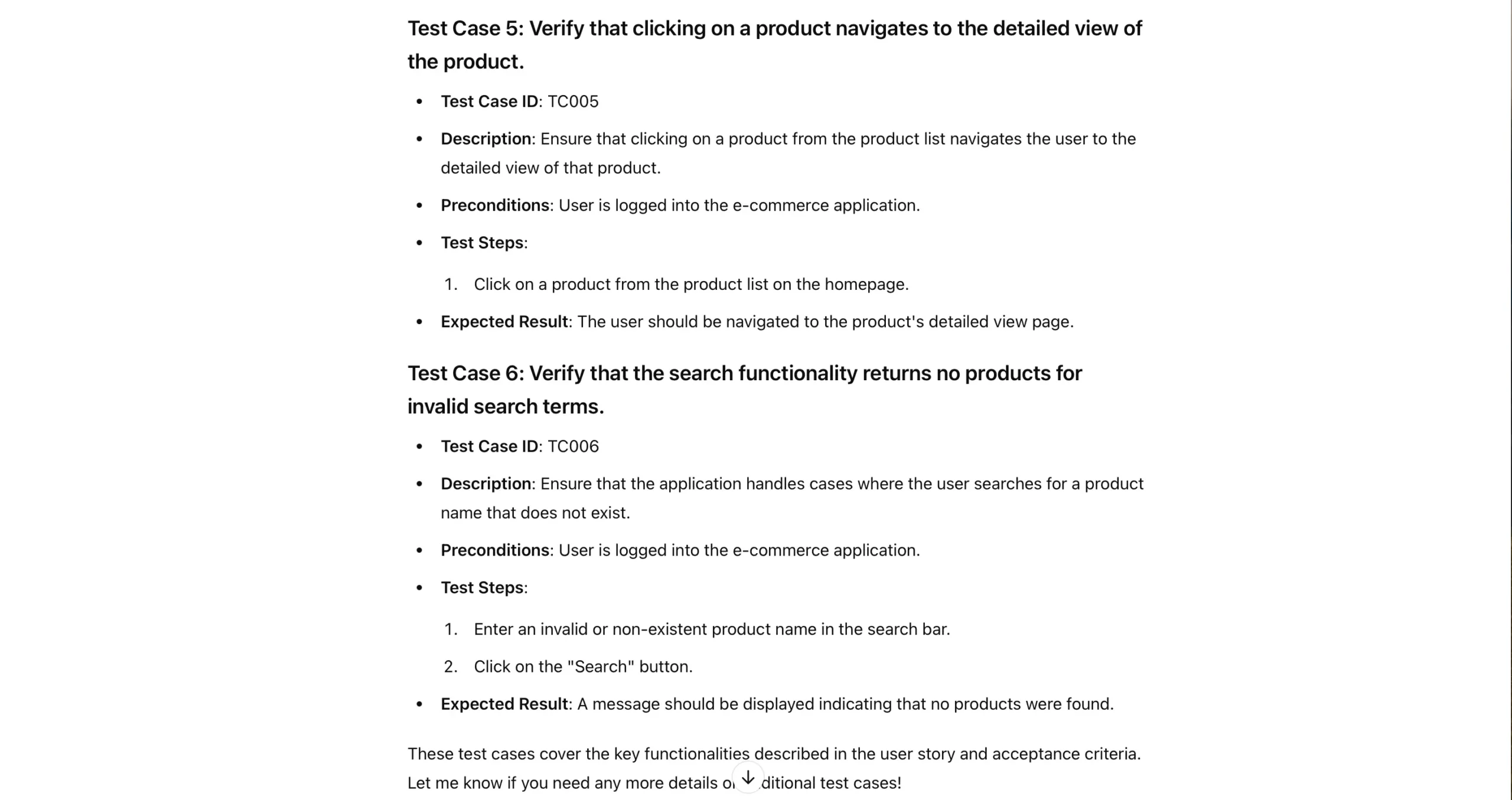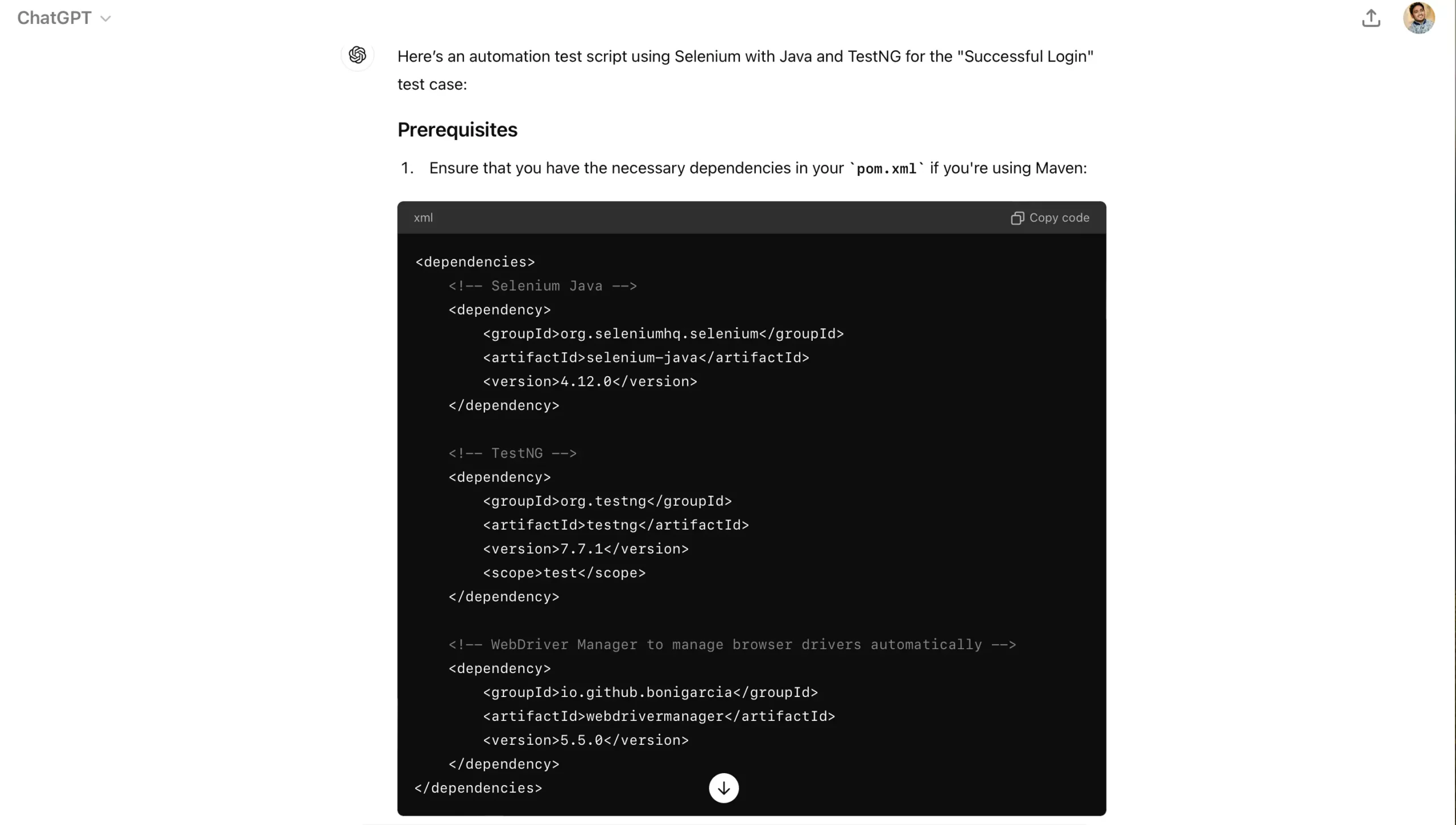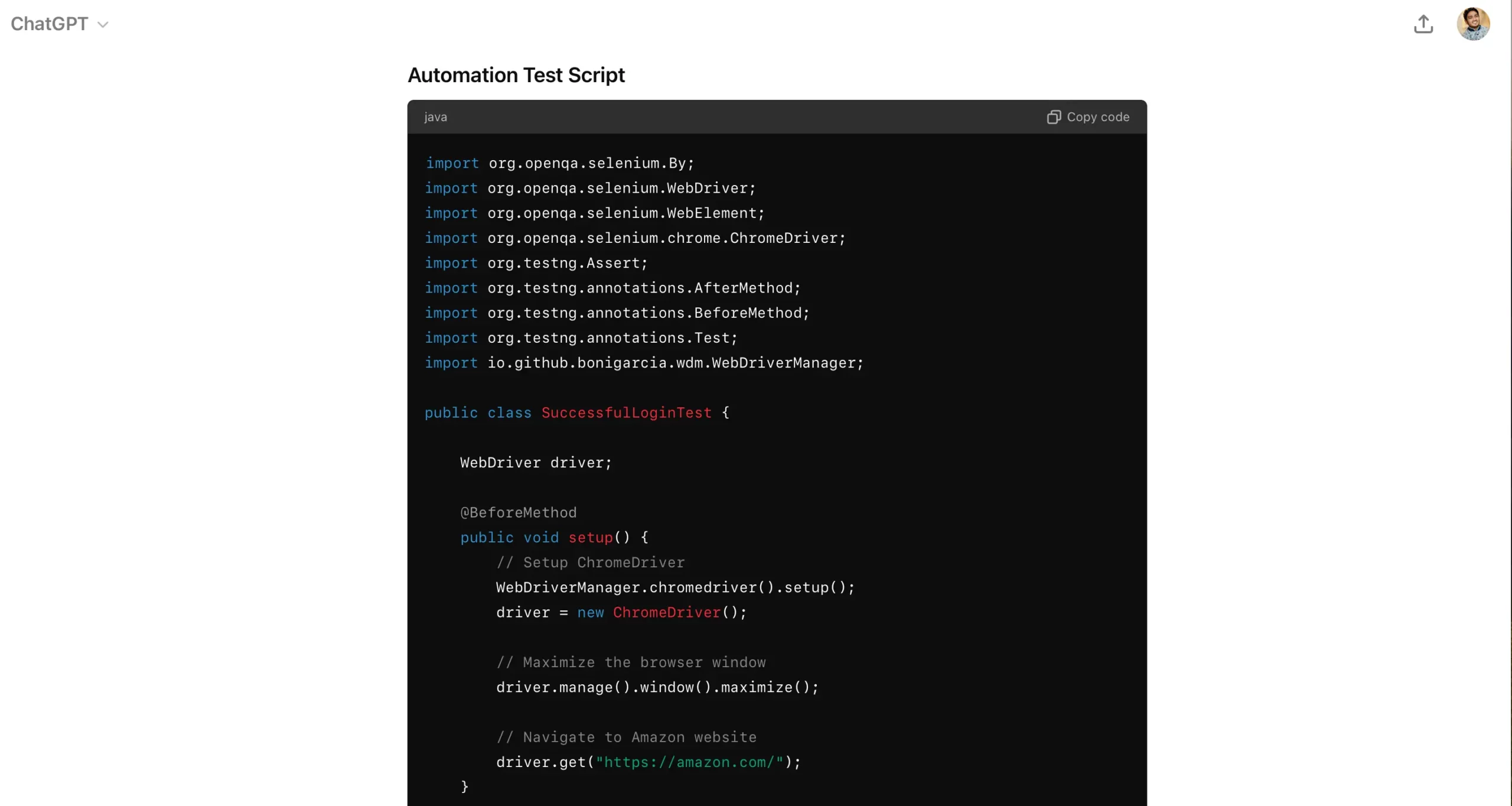Generative AI in Software Testing [with Practical Examples]
Generative AI in Software Testing is changing how we do quality assurance. This new technology is revolutionizing software testing, with powerful capabilities in creating test cases, automating documentation, and predicting bugs.
As the software industry keeps evolving quickly, GenAI in Software Testing has become a game-changer. It helps QA teams deliver higher-quality software faster than before.
By automating tedious tasks and improving test coverage, this transformative technology is shaping the future of software testing. It’s pushing the boundaries of what’s possible in ensuring the quality of our applications.

Market Trends: According to MarketsAndMarkets, the Generative AI market is witnessing exponential growth, with projections indicating a remarkable increase in market value—from USD 20.9 billion in 2024 to an impressive USD 136.7 billion by 2030, reflecting a compound annual growth rate (CAGR) of 36.7%.

What is Generative AI?
Generative AI is a type of artificial intelligence that can create new content, such as text, images, music, videos, code and more. Unlike traditional AI that only analyzes data and makes decisions based on it, generative AI models goes a step further by producing original material that resembles the type of input it has seen before. For example, when you ask a generative AI like ChatGPT to write a story or an article, it uses patterns it has learned from countless examples to generate a piece that is coherent and relevant.
At its core, generative AI relies on complex algorithms and models to understand the relationships within data. One common approach is called a neural network, which is designed to mimic how the human brain works. These networks can learn from vast amounts of information, picking up on subtle nuances and styles. This allows generative AI to assist in various fields, from creative writing and design to software development and testing. By automating content creation, generative AI can save time and inspire innovative ideas, making it a powerful tool for individuals and businesses alike.
Types of Generative AI Models
Generative AI encompasses various models, each tailored for specific applications. Here are some of the key types:

#1. Generative Adversarial Networks (GANs)
GANs consist of two neural networks, a generator and a discriminator, that work against each other. The generator creates new data instances, while the discriminator evaluates their authenticity (dentify real vs. generated samples), pushing the generator to improve its outputs continuously. This model is commonly used in image, video, and other media generation and has applications in art, fashion, and gaming.
Some notable examples of GANs include:
- DeepArt: This application transforms photos into artwork by mimicking the styles of famous artists through GANs.
- Runway ML: A platform that provides creative tools for artists and designers, enabling them to generate and manipulate media using GAN technology.
- Artbreeder: A collaborative art creation tool that allows users to blend images and create unique artworks through the use of GANs.
- NVIDIA GauGAN: This application enables users to create photorealistic landscapes simply by drawing rough sketches, showcasing the capabilities of GANs in generating high-quality images.
#2. Variational Autoencoders (VAEs)
VAEs are used to encode input data into a compressed representation and then decode it to create new samples. They are particularly useful in generating variations of given data, enhancing tasks like image restoration and text generation.
Some notable examples of VAEs include:
- DeepDream: Originally developed by Google, this application uses VAEs to transform images into dream-like visuals by enhancing and modifying patterns found within the images.
- VAE for Generative Text: Various natural language processing models leverage VAEs to create coherent and diverse text, allowing for storytelling or dialogue generation.
- Face Generation: VAEs are utilized in applications that generate realistic human faces, creating diverse appearances based on various attributes such as age, gender, and ethnicity.
- Image Denoising: Various tools implement VAEs for image restoration, effectively removing noise from corrupted images while reconstructing high-quality outputs.
#3. Transformer-based Models
This model architecture has gained widespread attention for its effectiveness in natural language processing. Transformers can generate coherent text, translate languages, and even produce visual outputs. Models like OpenAI’s GPT series and Google’s BERT are built on transformer architectures.
Some notable examples of Transformer-based Models:
- OpenAI’s ChatGPT: A conversational AI model that produces human-like text based on the context of interactions, making it ideal for customer support and virtual assistants.
- Google Translate: This application employs transformer models to deliver accurate and contextually relevant translations between multiple languages, vastly improving multilingual communication.
- BERT for Sentiment Analysis: Bidirectional Encoder Representations from Transformers (BERT) is widely used for sentiment analysis, allowing companies to gauge customer opinions from social media and reviews.
- DALL-E: An innovative image generation tool that creates unique images from textual descriptions, showcasing the potential of transformers in visual creativity.
#4. Diffusion Models
These models generate data by gradually transforming noise into coherent outputs, leveraging a reverse process of data corruption. Diffusion models have shown remarkable results in generating high-quality images and are gaining traction in both text and audio generation. DALL-E 2 and Stable Diffusion are prominent examples of diffusion-based generative models.
Some notable applications that utilise diffusion models include:
- DALL-E 2: An advanced version of the original DALL-E, which generates detailed images from text descriptions by refining the output through a series of diffusion steps.
- Stable Diffusion: A powerful image synthesis model designed to create high-quality images from prompts, which has gained popularity for its accessibility and performance in generating artistic visuals.
- Midjourney: An innovative tool focused on creating stunning visuals based on textual prompts, leveraging diffusion techniques to enhance creative output.
- DeepAI’s Image Generator: This online tool employs diffusion models to generate unique images based on user-defined prompts, providing a straightforward interface for creative experimentation.
#5. Autoregressive Models
Autoregressive models, like WaveNet for audio generation, generate output samples sequentially, with each new sample conditioned on the previous ones. They are well-suited for tasks like language modeling, speech synthesis, and music composition.
Some notable applications that utilize autoregressive models include:
- GPT-3: A state-of-the-art language model developed by OpenAI, which generates human-like text by predicting the next word in a sequence based on previous context.
- WaveNet: Created by DeepMind, this model is used for generating high-fidelity audio, enabling realistic speech synthesis and music composition by producing audio waveforms sample by sample.
- OpenAI Jukebox: A neural network that generates music with singing in a variety of genres and styles, utilizing autoregressive techniques to create coherent soundtracks.
- PixelCNN: An image generation model that produces images pixel by pixel, conditioned on the previously generated pixels, allowing for high-quality image synthesis.
These are some of the main types of generative AI models, each with its own strengths and applications. The field of generative AI is rapidly evolving, with new and hybrid models emerging regularly.
Evolution of Software Testing: From Manual Testing to Generative AI
The evolution of software testing has undergone significant transformations, beginning with manual testing, progressing to automation testing, and now advancing towards the innovative realm of generative AI.
Initially, manual testing was the cornerstone of quality assurance, where testers meticulously executed test cases to identify defects. While this approach provided deep insights into user experiences, it was time-consuming and prone to human error.
With the advent of automation testing, organizations began leveraging automation testing tools and scripting to automate repetitive tasks, significantly increasing efficiency and coverage. Automation allowed for quicker regression testing and the ability to run extensive test suites with minimal resource allocation. However, even with automation, there remained challenges in maintaining test scripts and ensuring comprehensive coverage.
The introduction of data-driven testing further refined this process, allowing QA teams to separate test logic from test data. This strategy not only improved test coverage and accuracy but also simplified the maintenance of test cases as changes occurred. It not only promotes efficiency in identifying defects but also ensures that applications perform reliably across diverse scenarios, ultimately delivering a robust user experience.
Building on these foundational strategies, generative AI now stands at the forefront of the testing evolution. By analysing historical data and user behavior, generative AI technologies are capable of creating diverse test cases autonomously. This not only enhances the range of scenarios tested but also aligns testing efforts more closely with actual user experiences. As this technology continues to develop, the future of software testing looks promising, offering enhanced automation, adaptability, and precision.
What is Generative AI in Software Testing?
Generative AI in software testing refers to the use of advanced artificial intelligence techniques to create test cases or identify bugs that can aid in testing software applications. This technology enables testers to automate the process of generating test cases, inputs, or even entire scenarios, thereby enhancing the efficiency and effectiveness of the testing process. Instead of manually creating every possible test case, generative AI can analyze existing data and generate new test cases that cover various edge cases and user behaviours, significantly reducing the time and effort needed.
For example, a generative AI model can be used to create a variety of input strings for an application, simulating different user interactions and ensuring that the software behaves as expected under diverse conditions. Another practical use is in automated user interface testing, where generative AI can produce numerous UI test scenarios that might not have been considered by human testers. Additionally, generative AI can assist in identifying potential bugs by continuously learning from past testing outcomes and suggesting new test strategies based on historical data. Overall, incorporating generative AI into software testing allows teams to improve their testing practices, leading to higher quality and more reliable software products.
Test Case Generation Using Generative AI
Test case generation using generative AI leverages algorithms and machine learning techniques to automate the creation of diverse and comprehensive test scenarios. By analyzing historical data from previous tests, user interactions, and application specifications, generative AI can identify patterns and informedly construct new test cases that may not have been considered. This approach not only increases test coverage but also prioritizes cases that are more likely to uncover defects, thus optimizing the overall testing process. Furthermore, as generative AI continuously learns from new data, it can adapt and improve its case generation strategies over time, leading to more robust software testing practices.
Identifying Software Bugs Using Generative AI
Identifying software bugs using generative AI involves the application of intelligent algorithms to detect potential flaws and vulnerabilities within applications. This technology analyzes the software code and its attributes, leveraging data from user interactions and previous bug reports to pinpoint anomalies that may lead to errors. By simulating user behaviours and testing various scenarios, generative AI can uncover hidden bugs that might be missed during traditional testing approaches. This proactive identification allows developers to address issues earlier in the software development lifecycle, ultimately ensuring a more reliable and user-friendly application. Moreover, generative AI’s capability to learn and adapt means that it can continually refine its bug detection processes, improving accuracy and efficiency over time.
Benefits of Generative AI in Software Testing
The integration of generative AI into software testing presents numerous advantages that significantly enhance the efficiency and effectiveness of the testing process. In the section, we will explore the key benefits that generative AI brings to software testing and how it revolutionizes traditional practices.

- Increased Efficiency: Generative AI can automate the creation of test cases, saving time for testers and allowing them to focus on more complex tasks.
- Enhanced Test Coverage: By generating a wide range of test scenarios, generative AI ensures that more aspects of the software are tested, reducing the risk of missing bugs and ensure better test coverage. The AI can identify gaps in existing test cases and recommend additional tests to cover edge cases or less-frequent scenarios that may be overlooked.
- Early Bug Detection: Generative AI identifies potential issues early in the development process, which makes it easier and cheaper to fix problems before the software is released.
- Cost Reduction: By streamlining the testing process and reducing the need for extensive manual testing, generative AI can lower overall testing costs.
- Predictive Analysis: Generative AI can predict which areas of the software are most likely to fail based on historical data. This allows QA teams to focus their testing efforts on high-risk areas, optimizing resource allocation.
- Continuous Learning: Generative AI systems can improve over time by learning from past testing experiences. This continual learning process allows them to produce better test cases and predictions, enhancing the overall efficiency of the QA process.
- Collaboration with Developers: AI tools can facilitate better communication between QA and development teams by providing actionable insights. This helps both teams to collaborate more effectively and ensures that the software quality is maintained throughout the development lifecycle.
Challenges of Generative AI in Software Testing
While generative AI offers numerous benefits to software testing, its implementation is not without challenges. As organizations integrate these advanced technologies, they encounter various obstacles that can impact the effectiveness of their testing processes. Understanding these challenges is crucial for ensuring a smooth transition and maximizing the potential of generative AI in enhancing software quality. In this section, we will delve into the key challenges faced by teams adopting generative AI in their testing workflows.
- Setup Complexity: Implementing generative AI systems can be complex and require significant resources, including specialized knowledge and infrastructure.
- Quality of Data: The effectiveness of generative AI relies on high-quality data for training. Poor or biased data can result in inaccurate test cases and buggy applications.
- Integration Issues: Integrating generative AI with existing testing frameworks might pose challenges, requiring adjustments to current processes and tools.
- Dependence on Algorithms: Over-reliance on AI-generated tests may lead to gaps if not complemented by human oversight, as AI might not fully understand all contexts or nuances of software usage.
- Cost of Implementation: Although it can reduce long-term costs, the initial investment in generative AI technology and training can be high for some organizations.
Generative AI Tools for Software Testing
Generative AI is revolutionising the realm of software testing by providing tools that enhance efficiency and accuracy in generating test cases, documentation, and supporting various testing processes. Here are some examples of how generative AI tools can be leveraged in software testing:
- Test Case Generation: AI-powered systems like Testrigor and Functionize TestAGENTS utilise machine learning algorithms to automatically generate test cases based on user prompts, application behaviour and user interactions. This significantly reduces the time and effort needed to create comprehensive test coverage.
- Documentation Generation: Generative AI tools like notion AI can auto-generate technical documentation. By analyzing requirements and test results, these models can generate clear, concise, and comprehensive documentation..
- Code Assistance: Tools such as GitHub Copilot, and Anthropic’s Claude can help with writing and refactoring test automation code. This not only speeds up the development process but also helps in crafting tests that accurately reflect application requirements.
- Cross-Browser Testing: Platforms like BrowserStack and Sauce Labs employ generative AI to automate multi-browser testing. They can create scripts that efficiently validate web applications across different browsers and environments, ensuring consistent user experiences.
- Web and Mobile Testing: Generative AI can facilitate end-to-end testing for both web and mobile applications. Tools like Applitools use AI-driven visual testing capabilities to detect UI discrepancies across various devices and screen sizes, ensuring a seamless interface for users.
These tools exemplify how generative AI is shaping the future of software testing, making it more adaptive, comprehensive, and ultimately more effective.
What is the impact of generative AI on QA job roles and the QA industry?
The rise of generative AI will inevitably impact job roles and work dynamics within the field.
These changes mean that the required skills and responsibilities for QA professionals are evolving. QA teams and individuals will need to adapt and develop new competencies like AI-driven testing.
While generative AI is not likely to replace QA jobs entirely, it will transform the nature of the work, requiring QA professionals to take on more strategic and analytical roles.
QA teams that embrace these technological advancements and upskill accordingly will be in high demand, while those who focus solely on routine, manual tasks may face challenges.
The key is for QA professionals to continuously learn, adapt, and position themselves as strategic partners in the software development lifecycle.
For starters, there will be a reduced need for manual testers, or at least, the nature of their jobs will evolve. Instead of repetitive, hands-on testing, they will need to assume roles that supervise and manage AI-driven testing, ensuring that the AI operates as intended. The role will also involve understanding and interpreting the results produced by the AI, and making informed decisions based on them.
Simultaneously, there will be an increased demand for QA professionals who are adept in AI technology. These individuals will not only need to understand how generative AI works, but also how to apply it efficiently in testing environments. They will be responsible for training and tweaking AI models, ensuring they are fit for purpose, and troubleshooting any issues that may arise during testing.
Consequently, there will be a shift towards more strategic, analytical, and technical roles within QA. This change will necessitate a focus on upskilling and reskilling within the industry to prepare current professionals for the AI-driven future.
Use Cases of Generative AI in Software Testing
Here are some generative AI use cases in software testing:

- Test Case Generation: Generative AI testing platforms can create test cases automatically. By analyzing the software requirements, user stories and design, it can suggest relevant test scenarios that need to be tested, thereby saving time and effort for QA teams.
- Test Data Generation: With the ability to create synthetic data, generative AI tools helps in managing test data more efficiently. This is especially useful for applications that require large volumes of varied data, as it ensures a more robust testing process without compromising on data privacy.
- Intelligent Bug Detection: Generative AI algorithms can analyze previous incidents and recognize patterns that indicate potential bugs in new code changes. This proactive approach can lead to quicker identification and resolution of issues before they affect users.
- Automation Scripting: For automated testing, generative AI can produce scripts by understanding the specifications. This allows for efficient test coverage and reduces the manual effort involved in writing and maintaining these scripts, making testing faster and more reliable.
- Automation Auto Heal: Generative AI enhances UI automation by providing smart mechanisms to adapt test scripts when the user interface changes. This auto-healing feature detects changes and updates the scripts accordingly, which saves time and effort in maintaining test cases.
- Improving Test Maintenance: As software evolves, tests need to be updated accordingly. AI can help identify obsolete tests and suggest necessary updates, making the maintenance process more efficient and less prone to human error.
Insights on ChatGPT for SDETs
As an experienced Software Development Engineer in Test (SDET), I’m excited to share how ChatGPT can enhance our testing processes and overall productivity. ChatGPT, a powerful generative AI tool, can assist SDETs in writing test cases, automating repetitive tasks, generating test scripts, and even reviewing code for potential issues.
One of the primary uses of ChatGPT in testing is its ability to create test cases from functional requirements. By simply providing the tool with a description of the intended functionality, SDETs can receive a set of relevant test cases which can save significant time in the test design phase. This feature is particularly useful when dealing with large applications with multiple features, ensuring comprehensive coverage without the manual effort of drafting each case.
Another way SDETs can leverage ChatGPT is through prompt engineering. By using specific prompts, testers can guide ChatGPT to provide tailored responses that fit their particular testing needs, whether it be generating scripts for Selenium, REST Assured, or integrating with CI/CD tools like Jenkins. This adaptability means SDETs can quickly iterate on test strategies and adjust to changes in requirements or testing environments.
Moreover, ChatGPT can be used as a code reviewer. By inputting snippets of code, testers can receive feedback on potential bugs or errors, as well as suggestions for improving code quality. This capability not only aids in catching issues early but also helps SDETs write cleaner, more efficient code.
Lastly, understanding how to integrate third-party plugins with ChatGPT opens up even more possibilities for SDETs. This integration can help streamline workflows and enhance the functionality of existing testing frameworks, making the overall testing process much more efficient.
ChatGPT serves as a valuable ally for SDETs, streamlining various aspects of testing, from case generation to code reviews. By embracing this technology, we can improve our efficiency and focus more on strategic testing initiatives.
How To Use ChatGPT In Software Testing (Practical Examples)
ChatGPT can be a valuable tool in software testing and automation, aiding testers and developers at various stages of the process. By leveraging ChatGPT, you can quickly brainstorm ideas for user stories, generate test cases, and even create automation scripts, thus saving time and enhancing productivity. For example, you can ask ChatGPT to help you think through acceptance criteria or to create detailed steps for testing a specific feature, which can streamline your workflow and improve the overall quality of your applications.
Let’s see some practical examples of using ChatGPT in Software Testing
#1. User Stories Creation using ChatGPT
Sample prompt I provided in ChatGPT is
I would like to create user stories for the below requirement.
Requirement: As a user, I should be able to log into an e-commerce application and easily add products to my cart.Logged in to my ChatGPT account and entered the prompt mentioned above to create user stories using ChatGPT.

The response from ChatGPT can be found in the images below.




#2. Test Case Creation using ChatGPT
The prompt I used here is picked from the output generated in the earlier User Story Creation step.
I would like to create Test Cases for the below User Story Browse Products
Title: Product Browsing
As a: Logged-in User
I want to: browse through available products in the e-commerce application.
So that: I can view product details and choose the ones I want to purchase.
Acceptance Criteria:
The user should be able to see a list of products on the homepage.
The user should be able to search for products by name, category, or other filters.
Each product should display its name, price, and a brief description.
Clicking on a product should navigate to a detailed view of the product.The prompt mentioned above to create test cases using ChatGPT has been entered into ChatGPT.

The response from ChatGPT can be found in the images below.



#3. Automation Test Script Creation using ChatGPT
Prompt: Create an automation test script using Selenium with Java and TestNG for the following test case:
Test Case : Successful Login
Preconditions: The user must possess valid credentials.
Test Steps:
1) Launch the Chrome browser and navigate to "https://amazon.com/".
1) Navigate to the login page.
2) Input the valid user ID and password.
3) Click the "Login" button.
Expected Result: The user should be successfully logged in and redirected to the homepage.The prompt mentioned above to create automation test scripts using ChatGPT has been entered into ChatGPT.

ChatGPT has provided code along with its explanation. The response from the ChatGPT can be found in the images below.





The use cases for ChatGPT in software testing and automation are vast and varied. From simplifying documentation to generating test data, its capabilities can help teams work more efficiently and effectively. By incorporating ChatGPT into your testing practices, you can not only reduce repetitive tasks but also foster creativity in problem-solving and improve team collaboration. The potential applications are truly endless, making it a powerful ally in the software development lifecycle.
Frequently Asked Questions
Difference between AI and GenAI?
Artificial Intelligence (AI) refers to computer systems that can perform tasks typically requiring human intelligence, such as understanding language, solving problems, or recognizing patterns. Generative AI (GenAI), on the other hand, is a subset of AI designed specifically to create new content, such as images, text, or music, based on learned patterns from existing data. While AI can analyze and make decisions based on input, GenAI focuses on generating original content, showcasing creativity and innovation within the realm of artificial intelligence.
What is the role of QA in generative AI?
The role of Quality Assurance (QA) teams in generative AI involves ensuring that the AI models produce reliable and accurate results. QA professionals test the models to identify any biases, errors, or inconsistencies in the outputs. They also evaluate the performance of the AI in real-world scenarios, helping to refine the algorithms and improve user experience. By maintaining high standards for quality, QA plays a vital role in building trust in generative AI technologies.
What is GenAI in STLC?
Generative AI (GenAI) in Software Testing Life Cycle (STLC) refers to the use of advanced AI technologies to automate and enhance various testing processes. It can generate test cases, simulate user interactions, and provide insights from data patterns, making testing more efficient and effective. By leveraging GenAI, QA teams can reduce manual effort, speed up the testing process, and improve the overall quality of the software.
How to Develop a QA Strategy with Generative AI?
To create an effective QA strategy using generative AI, start by identifying the processes and areas where AI can add value, such as test case generation and defect prediction. Involve your QA team to collaborate with AI tools, ensuring they understand how to integrate AI outputs into their workflows. Focus on training the AI models with relevant data to improve accuracy in testing scenarios. Finally, continuously evaluate the performance of the AI tools and refine your strategy based on feedback and testing results to enhance overall software quality.
How can generative AI be used in software testing?
Generative AI eases our life by automating complex test case creation, reducing manual effort, and enhancing efficiency. It creates realistic test data that replicates actual usage patterns, ensuring more robust and comprehensive testing processes. This saves time and increases the coverage and reliability of tests.
Conclusion
The impact of Generative AI in Software Testing is huge. It’s automating time-consuming tasks and giving us deeper insights. This technology is really changing the future of quality assurance. As the industry embraces these advancements, QA professionals need to adapt and learn new skills. They’ll need to become strategic partners in the software development process. The power of Generative AI is shaping the future of software testing. Those who use this technology well will be able to drive innovation, improve quality, and stay ahead of the competition.
Related posts:
- Prompt Engineering In Software Testing
- AI In Software Testing
- 50+ Prompt Engineering Interview Questions
- How To Become A Prompt Engineer
- 60+ Artificial Intelligence Interview Questions
- 10 Best Artificial Intelligence Software






